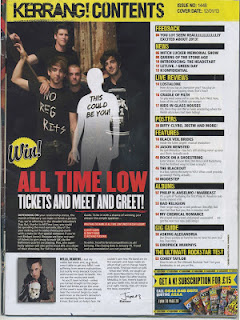NME front cover
Image
This magazine used a close up shot of a model wearing sun glasses looking off into the distance. The image takes up the majority of the page and is in black and white. The male soloist is wearing dark clothing and isn't pulling any facial expression and has quite blank look on his face. I really like how this model is wearing sun glasses, therefor will experiment what this idea and possibly get my model to wear sun glasses in my photo. Although a lot of magazine dont use model's wearing sun glasses, I personally think that this image is very effective and gives the soloist a look is being 'cool.' I also really like how the photo dominated the front cover, and goes behind the masthead.
Mast head
The mast head is written in the red colour scheme used and is bold and dominant. It contrasted again the black and white background, therefor stands out. The masthead sits in front of the image, which is a feature I really like in a magazine, as it makes the mast head stand out, therefor gives the magazine its own identity, and isn't masked by a image.
Colour scheme
Again, this magazine used a tri colour scheme, where there are 3 district colours, which all contrast each other making it bold and stand out. The most important text is coloured in red as well, resulting in the word 'Liam' standing out as not only is the written in a very large clear bold font, but is also coloured by the red colour scheme. I really like the feature of the most important text being coloured in red, as it is easily indicated to the TA what is important and by glance is easily understood and readable.
Text
In this magazine front cover, the text is written across the whole page in a large bold font. Under the work 'Liam' there is a small descriptive piece of information telling the audience what the article is about. The sub text under this says 'answers your questions' and the 'your' part is written in red. I really like the feature of text where the main article stands out due to it being so large and coloured in red. I also really like how the sub article information directs the audience personally by saying that 'Liam' will answer questions from the audience. I really like these features therefor will use them on my front cover.
Fonts
This magazine uses a very plain basic, simple, easy to read font and is very bold and sharp throughout. All the text on the front cover is in capitals making it easier for the audience to read and stands out more than regular lower case letters. I really like the feature of only using capitals on the front cover, and how the font is a very sharp bold font as it is clear and easy to read.



























